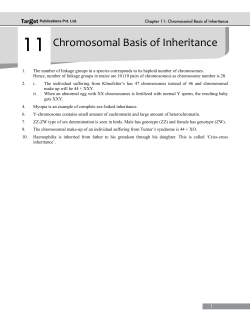
1.
Inheritance & Meiosis Practice Problems 1. What is a difference between autosomes and sex chromosomes? A. Autosomes are not found in gametes but sex chromosomes are. B. Sex chromosomes are found in animal cells and autosomes are found in plant cells. C. Autosomes are diploid and sex chromosomes are haploid. D. Sex chromosomes determine gender and autosomes do not. (Total 1 mark) 2. (a) State the names of the parts of the chromosome labelled (i) and (ii) on the diagram below. (2) [Source: adapted from Hartwell (editor) (2003), Genetics: from Genes to Genomes, 2nd edition, McGraw Hill, page 81] (b) Explain how the inheritance of chromosome 21 can lead to Down’s syndrome. (3) (c) Explain how meiosis promotes variation in a species. (2) (Total 7 marks 3. Karyotyping involves arranging the chromosomes of an individual into pairs. Describe one application of this process, including the way in which the chromosomes are obtained. (Total 5 marks) 4. The diagram below shows a cell during meiosis. How many chromosomes would each daughter cell have at the end of meiosis? A. 1 C. 4 B. 2 D. 8 (Total 1 mark) 5. (a) Define sex linkage. (1) (b) State one example of sex linkage. (1) (c) Draw a simple pedigree chart that clearly shows sex linkage in humans. Use conventional symbols. Start with an affected woman and an unaffected man. (4) (Total 6 marks) 6. The pedigree below shows which members of a family were Rhesus positive (■ and •) and Rhesus negative (□ and O). The allele for Rhesus positive blood (Rh+) is dominant over the allele for Rhesus negative blood (R-). Which are possible genotypes of the individuals numbered I, II and III? A. B. C. D. I Rh Rh+ Rh+ Rh+ Rh+ Rh+ Rh+ Rh– + II Rh Rh+ Rh+ Rh– Rh+ Rh– Rh+ Rh– + III Rh Rh– Rh+ Rh+ Rh+ Rh– Rh+ Rh+ + (Total 1 mark) 7. Outline one example of inheritance involving multiple alleles. (Total 5 marks) 8. In garden peas, the pairs of alleles coding for seed shape and seed colour are unlinked. The allele for smooth seeds (S) is dominant over the allele for wrinkled seeds (s). The allele for yellow seeds (Y) is dominant over the allele for green seeds (y). If a plant of genotype Ssyy is crossed with a plant of genotype ssYy, which offspring are recombinants? A. SsYy and Ssyy B. SsYy and ssYy C. SsYy and ssyy D. Ssyy and ssYy (Total 1 mark) 9. The allele for red flower colour (R) in a certain plant is co-dominant with the allele for white flowers (R’). Thus a plant with the genotype RR’ has pink flowers. Tall (D) is dominant to dwarf (d). What would be the expected phenotypic ratio from a cross of RR’dd plants with R’R’Dd plants? A. B. C. D. 9:3:3:1 50% pink 50% white, and all tall 1:1:1:1, in which 50% are tall, 50% dwarf, 50% pink and 50% white 3:1 (Total 1 mark) 10. (a) A farmer has rabbits with two particular traits, each controlled by a separate gene. Coat colour brown is completely dominant to white. Tailed is completely dominant to tail-less. A brown, tailed male rabbit that is heterozygous at both loci is crossed with a white, tail-less female rabbit. A large number of offspring is produced with only two phenotypes: brown and tailed, white and tail-less, and the two types are in equal numbers. (i) Deduce the pattern of inheritance of these traits. (2) (ii) State both parents’ genotypes and the gametes that are produced by each during the process of meiosis. Male genotype: ........................................................................................ Female genotype: ........................................................................................ Male gametes: ........................................................................................ Female gametes: ........................................................................................ (2)
© Copyright 2025
















![A second allele of spectrin alpha-gene associated with the alpha... phenotype (allele alpha Ponte de Sor) [letter]](http://cdn1.abcdocz.com/store/data/000433982_1-7a90b3a848440f2a386dffd94e3d007e-250x500.png)




